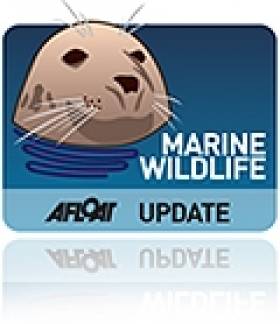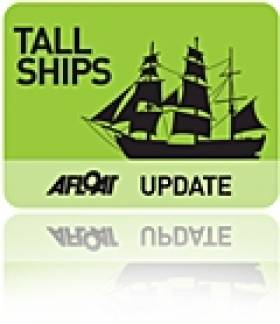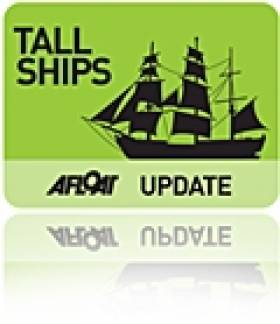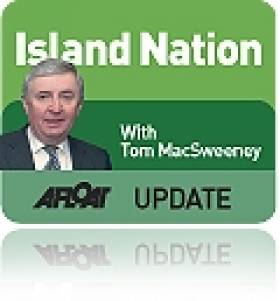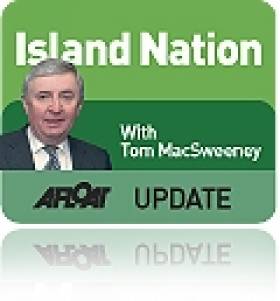Displaying items by tag: Tall Ships Race
Celtic Mist Will Track Elusive Blue Whale
The infamous Celtic Mist is set to be used to track one of the most elusive marine animals in Irish waters.
The Irish Examiner reports that one of the first duties of the yacht under its new ownership by the Irish Whale and Dolphin Group (IWDG) will be to track down the blue whale, the last of which was spotted off the Irish coast in 2009.
"We’ve made two sightings of the blue whale on the shelf edge but with the Celtic Mist we will be able to go out there for a few weeks and sit there and wait for them," said the IWDG's Dr Simon Berrow.
"Hopefully we will find some more when we bring the Celtic Mist out there. They are very rare."
The blue whale is regarded as the largest animal to have ever lived on earth. They also have an average lifespan of well over 100 years.
As previously reported by Afloat.ie, Celtic Mist was gifted by the Haughey family to the IWDG earlier this year to assist in its marine conservation work.
The yacht competed in a leg of the 2011 Tall Ships Race from Waterford to Scotland before moving to its new home in Co Clare, where it will be refitted for its new life as a research vessel.
Tall Ships kicks off with 80,000 turnout in Waterford
With an estimated 80,000 people turning out to welcome the Tall Ships yesterday, things are hotting up in Waterford. Aswell as the Tall Ships themselves there are craft and food villages in the city centre throughout the weekend. Traffic restrictions are in place over the three-day event so plan for some delays. The Tall Ships sail out on Sunday morning to start the race.

Russian Ship, Mir, docked at the northern quays in Waterford, at 109m in length, it is the largest of the Tall Ships.

A view of the smaller ships docked down the south quays in Waterford

Polish Ship the Wylde Swan, one of the last ships to arrive for the festival.

Norwegian Ship, Christian Radich docked at the northern quays.

Fireworks Display to end the days festivities.
Waterford Tall Ships Plans Revealed
Waterford has unveiled its sailing plans to celebrate the arrival of the Tall Ships Race this summer.
The Irish Times reports that more than half a mllion people are expected to visit the city from 30 June to 3 July to see the majestic vessels - and they are set to be entertained by a variety of street events and live performances.
Sharon Shannon, The Waterboys and magician Keith Barry are among those lined up for the weekend's festivities.
Fáilte Ireland chair Redmond O’Donoghue compared the Tall Ships visit to the Volvo Ocean Race visits to Galway, and said it would be “a talking point for many years to come”.
A new multi-million euro jetty for Waterford Harbour designed to accommodate the ships will be ready in time for the race arrival.
The Irish Times has more on the story HERE.
Looking for further reading on Tall Ships in Ireland? Click the links below:
Click this link to read all our Tall Ships Stories on one handy page
Previewing Ireland's Tall Ships 2011 Season
Can Ireland Get a New Tall Ship?
Could Waterford Lead a Tall Ships Revival?
I am aware that a number of groups are examining the possibility of launching a national sail training programme. I wonder if Waterford could be the place to lead it and be the base for national sail training. The marine sector suffers from the neglect and disregard of a disinterested Government so any revival will have to be outside of State support.
Waterford staged a hugely successful visit of the Tall Ships Race in 2005 and has been honoured with the hosting of the Race start next year. Bertie Ahern as Taoiseach snubbed the Race visit in 2005. It showed how little respect he had for the maritime sector. Half-a-million people visited the city, but Bertie couldn't be bothered to do so.
The city has been encouraging young people to get experience of crewing aboard Tall Ships. Twenty-year-old David Murray, a business information systems student at University College Cork, is becoming a sail training "veteran" through experience gained over the past two years.
He first 'shipped out' last year aboard the Tenacious operated by the Jubilee Sailing Trust of the UK, a registered charity which also operates the Lord Nelson. His first voyage, following which he sailed the north coast of Scotland on the Lord Nelson and this year became a Bosun's Mate, taking more responsibility aboard the Nelson on a voyage from Southampton to Glasgow. Then he joined the Dutch three-masted schooner, Eendracht, from Kristiansand in Norway to Hartlepool in the UK, where he disembarked and re-joined the Tenacious, again as Bosun's Mate, sailing to Bruges in Belgium and onto London. A few days later he was back aboard the Lord Nelson as Bosun's Mate from Falmouth to Milford Haven in Wales and then to Waterford, from where the Tall Ships Race will start next year,
"It's been a brilliant experience. I've met a great mix of people. Sail training is for everyone," he said. "It's been a very busy but great couple of summers with Tall Ships and I'm really looking forward to next year, especially with Waterford again hosting the fleet and crews from around the world coming to the city. I strongly recommend sail training and the fact that the races start from Waterford next summer makes it even easier for Irish young people to get involved."
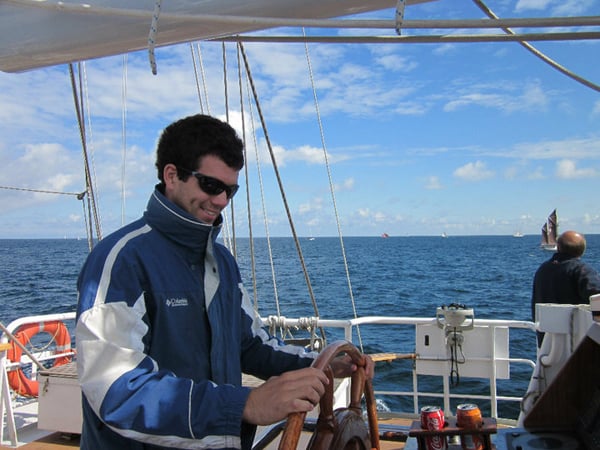
David Murray is a Tall Ships veteran at the age of 20
David comes from Butlerstown in Waterford. His pleasure in the experience of tall ship sailing underlines what has been lost by the shameful behaviour of the Government in closing down the sail training programme.
It will be a national disgrace if there is not an Irish tall ship flying the Tricolour at next year's Tall Ships Race start in Waterford. The city has done magnificent work in putting Ireland to the forefront in the world of tall ships. Perhaps Waterford should be the base for the creation of a new national sail training system.
• This article is reprinted by permission of the EVENING ECHO of Cork where Tom MacSweeney writes maritime columns twice weekly. Evening Echo website: www.eecho.ie
O'Dea Escapes on Late Late Show
Willie O'Dea appeared on RTE's Late Late Show on September 10. The following day, September 11, was a major day in Irish maritime history - the second anniversary of the sinking of the national sail training vessel, Asgard. O'Dea did not have a difficult time on the Late Late Show which did not pursue an important aspect of his career – his decision to abandon the national sail training programme.
Why is it that the Dublin-based national media have such little awareness of the maritime sphere? How could the researchers on the Late Late Show, promoted as a top RTE programme, ignore Mr.O'Dea's actions and challenge his misleading public statements on this issue?
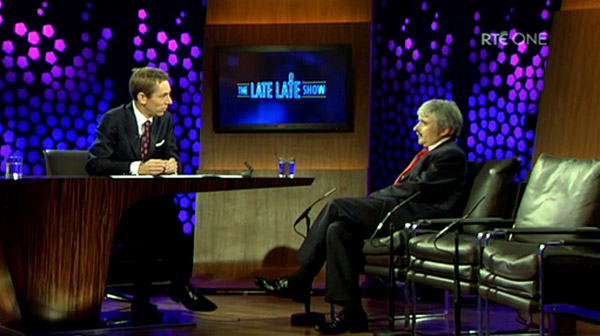
Ryan Tubridy interviews Willie O'Dea on the Late Late Show
He is on public record as Minister in pledging the replacement of Asgard. But while he said one thing, he did another, though attempting to pass the responsibility sideways to the Asgard committee, which, of course, he had appointed and which failed to challenge him. Should Ministers not deliver on what they publicly commit themselves to? Willie O'Dea handed over the compensation money for the sinking of the national sail training vessel to the Department of Finance, a callous abandonment of the maritime traditions of this nation. Over 12,000 young people had been given sail training courses aboard Asgard during its 25 years of operation.
Now Ireland does not have a national sail training vessel, nor a national sail training programme. For a maritime nation, this is disgraceful.
Next year the international Tall Ships Race returns to Ireland. It will be hosted again in Waterford, which will have the honour of being the port to start the event. This will also be a great honour for Ireland.
But remember that when the Tall Ships Race was last in Waterford, in 2005, then Taoiseach Bertie Ahern never visited the event. That, in my view, was an insult to the occasion and I said so at the time, which did not go down well with the Government. But it is not my concern to be popular with a Government which has dealt with the sail training programme in an appalling way.
Nor am I concerned to be popular with my former employers, RTE. The Late Late Show failed to pursue O'Dea on a crucial maritime issue, which should have been its public service duty on a date and an occasion particularly relevant to the marine sector.
• This article is reprinted by permission of the Cork Evening Echo in which Tom MacSweeney writes maritime columns twice weekly. Evening Echo website: www.eecho.ie


























